Where To Stay In Split (8): Travel To the Socialist Era
There is a lot of logic to begin this series with the oldest part of Split, Diocletian's Palace, and to end it in the eastern part of the city, mostly developed during the 20th century. When watched from the air, it looks like most of the modern parts in cities around the world, but even though you will not find usual Mediterranean charm as in some older neighbourhoods, don't rule it completely out as your accommodation choice.

When we talk of new Split, we think of an area east of Bačvice and Firule, eastbound along the sea, and north of it, all the way to the city entrance from Solin or Dubrovnik directions. Or, east from Gripe, a neighbourhood we described in previous part. It's a huge area, highly populated, and mostly built in the socialism-era of Yugoslavia.

However, some of those buildings and streets are nice examples of modern residential architecture, especially parts locally called Split 3. This development, built in the 1970s, was internationally recognized as a good, human-oriented residential area. Unfortunately, it was never completely finished, which made it look a little bit worn out in some points. The latest addition is the new University of Split campus, still not finished completely.

In the last few years, with the explosive growth of tourist arrivals, this area has become a second choice for visitors. There are lots of apartments available in high-rises everywhere, AirBnB random search for mid-June gave really nice results. A nice advantage is that they are reasonably cheaper than those in the old town, and Split is not really that big to make it impossible to go sightseeing. By car, even with heavy traffic, it's possible to reach city center in 10 to 15 minutes. For those who like to walk, there is a nice solution - about an hour long walk by the sea.

Beside apartments, usually pretty comfortable and in good shape, there is one little bit more upscale option, Radison Blu Resort, 4-star hotel settled right above the Trstenik beach. Its features are as expected from the chain hotel, and with some small boutique hotels in the city center, this is one of the most luxurious hotels in Split today.
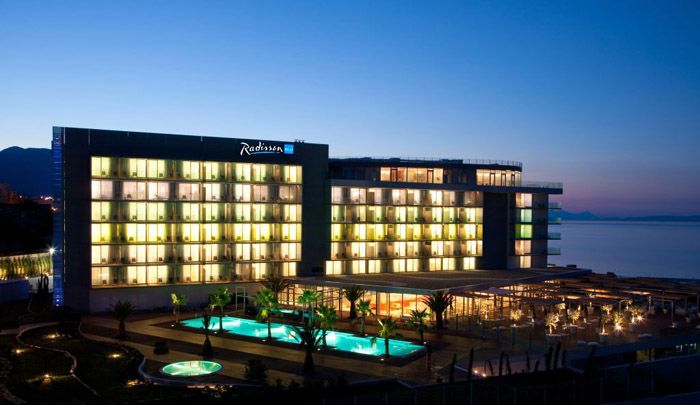
The hotel has its own swimming pool, but an easily accessible beach is not to be missed, as well as the excellent restaurants within the hotel. Of course, Radisson Blu is a very good solution for conferences and similar events.

The whole of new Split is very well connected if you are coming with the car, and most buildings have their own parking lots, or even garages. If you decide not to drive to the city for sightseeing, you can always use the Split public transportation system. Since most of the Split inhabitants live there, most of the bus lines pass there. Ticket bought in the bus is 11 kunas for adults, 5 kunas for children age 6 to 10, and free for those younger. You can also buy 10-ticket packs in news-stands, each ticket is for two rides, and costs 17 kunas.

There are no sightseeing attractions in new Split, except if you are a socialism-style junky. However, the coast is mostly arranged as the beach, especially parts around Trstenik, near Radisson Blu, and Žnjan (pron. Zhnyan) plateau. In the summer some parts can be a little bit crowded, but not as some even more popular beaches like Bačvice.


These places are just too big not to be able to accept lots of people. If the weather is not suitable for the beach and swimming, a walk by the sea is always refreshing. And in winter times Žnjan becomes a very popular windsurfing and kite surfing destination.

New Split is also nicely equipped with shopping sites. The closest to the old town is Joker Center. In the very heart of Split 3 lies the small but well Prima 3 which attracted lots of smaller stores to be opened in nearby streets. The biggest shopping center in Split, and in all Dalmatia is City Center One, easily accessible by car or by bus number 18.

Of course, there are some downsides of staying in new Split. For Split circumstances it's fairly far from the main attractions. Also, it's far from being charming and cozy as some small stone paved alleys and streets in the old town and its vicinity. If you just want to have a place to tuck in as a base for further explorations, or you are on a tight budget, this could be your choice.
The story about Split accommodation might not be ending here, as there are lots of places around Split with available apartments or hotel rooms. However, this is what Split neighbourhoods have for full enjoyment in everything this city can offer.
PREVIOUSLY IN WHERE TO STAY IN SPLIT
Choose Neighbourhood By Your Needs
Where To Stay In Split (7): Off the Beaten Path
Staying in the heart of a 1,700 year-old city is unbeatable, and as we have already seen in this series, the vicinity of Split old town has many advantages when it comes to accommodation. One of the parts of Split we would like to recommend is the big area northeast of the old town. Those neighbourhoods are locally known as Lučac (pron. Lootchats), Manuš (Manoosh), Gripe (Greepae), and a little bit further are Bol and Dobri (Dawbry). This is for many reasons a very convenient place to stay: it's only minutes away from the old town and all important attractions. Beaches are also very close, and apartment prices are very competitive, real value for money. These neighbourhoods are early examples of urban Split, and staying there might give you a really good insight into the way of living in Split. Unlike the old town, or Varoš, or even Bačvice, there are many inhabitants still living in their apartments, meaning in these areas it's possible to experience some real life. That also brings some responsibilities for guests - respect your neighbours, they are there longer than you.

This area gives you several different moods, and living styles. Closer to Diocletian's Palace you can find narrow streets and old stone houses, very much like those in the old town or even more like in Varoš. This is the most vivid in a street called Radunica, and surrounding alleys, which are packed with apartments and rooms during summer. There are even a few hostels around.

If you go further north and east bound, you will find nice quiet streets, but with bigger buildings. The further you go, the more Split changes its look, and becomes more modern. Nevertheless, it's still Split, with its unique atmosphere.

There are not so many attractions in this area, this is mainly residential. The biggest one by far is Gripe Fortress, with the Croatian Maritime Museum, including part of steam ship Bakar in its yard, which served as a convoy ship during WW2. If you are a basketball fan, very close to the fortress is the small sport arena, the home of Split basketball club, former Jugoplastika, which was named by FIBA as the best team in history. NBA players Toni Kukoč, Dino Radja, Žan Tabak, and many, many others are its legends.
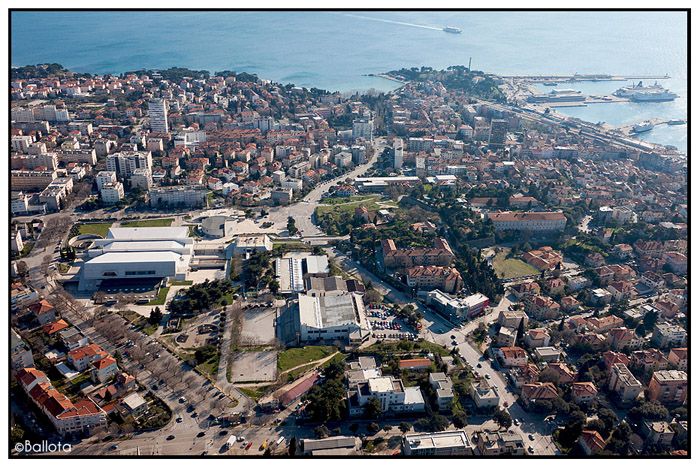
We have already said that accommodation in this part is easy to find, there are plenty of apartments. We typed in a random search for mid-June in AirBnB, and results are impressive, with some nice examples. However, there are not only apartments and rooms available, but also hostels, one of them was featured in Total Split, design hostel Emanuel.

On the verge of these neighbourhoods, especially on its northwestern edges, there are several good hotels, with four or even five stars, like President, than Best Western Art Hotel based in former pastry factory. Also, the best rated is business oriented Atrium, and there is also more moderate, but excellently located Globo.

Being a residential area usually means there is almost no nightlife, and that goes with this area, too. There is a club called Masters within the sport center on Gripe, and that's pretty much it. The same goes for bars, and restaurants. Go to the old town for gastronomy or liquid pleasures. Still, it can be fun to drink where locals drink, at least morning coffee. People in Split are very loud, in small amounts it can be interesting to foreigners. There is, of course, one special place, Total Split's favorite pub in Split, and the oldest one, too - Basket.

the downsides of this area, let's call it Split NE, are few. First, there is no tourist-oriented life (except accommodation), but that's not the big problem, especially for those who consider this as an upside. Also, this area has a problem with parking, like most of Split. There are paid parking lots closer to the Palace, but the rest is mostly left to your skills and luck. Not to mention that people who live there are also parked around. However, since it's so close to the old town, you can leave your car there and basically don't need to move it.
PREVIOUSLY IN WHERE TO STAY IN SPLIT
Choose Neighbourhood By Your Needs
Where To Stay In Split (6): Fun, Beach, Food
Probably right next to its history, and recently entrtainment, Split is famous for its beaches. There are not many cities of this size, maybe in the whole Mediterranean, with so many places where it's safe, fun and clean to enjoy the sea and beach. All around Marjan hill, and east of the city harbour, there is about 17 kilometres of sea line, and pretty much all of it suitable for swimming.

Still, there is one beach that comes to mind first when mentioning swimming in Split, Bačvice (pron. something like Bahtchweetse). In the last few years, tourists have re-discovered this place, and even though sometimes it can be too crowded, it's still popular. Bačvice is deeply anchored in Split mythology, and beside Diocletian's Palace this beach is one of the Split scenes that can be most frequently seen on TV or elsewhere. Once when you come there, there is no chance you will miss someone playing picigin (pron. pizzighin), beach fun played by five players with a small ball, usually made out of peeled tennis ball.
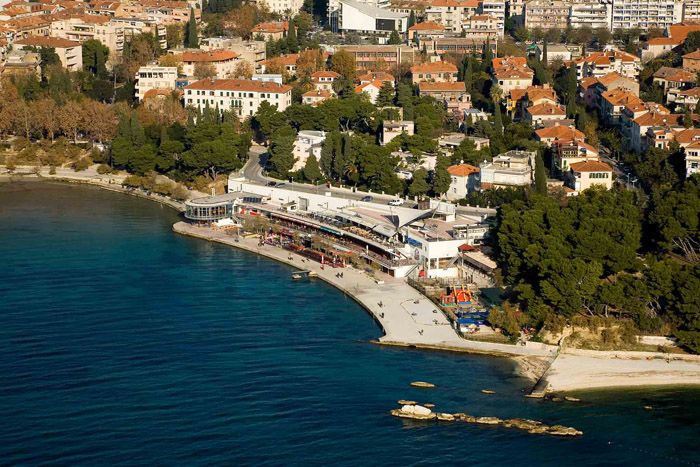

Of course, Bačvice is not only a beach. It's really a good place to stay. It is spread not only on area around namesake beach, but also through whole area from the city harbour to the main hospital, locally know as Firule, and in the north up to street called Kralja Zvonimira. There are lots of available apartments and rooms around, sometime in villas. This is one of the most urban parts of the old Split, meaning you can find anything, ranging from small and charming stone houses in the oldest part called Toć (pron. Totch), to apartments in larger, usually 1930s buildings, some of them are the most beautiful in Split.

Sadly, but this area is another proof that Split really lacks hotels. Even in this, strongly tourist neighbourhood there are only two, both 4-stars, tradition leaning Park and very modern Luxe. There are several hostels around the area, the rest are apartments and rooms.

One of the reasons why it is so popular to stay on Bačvice or Firule is its vicinity to the old town, as well as all means of transportation. Ferries to islands, bus and railway stations are in the walking range, the same goes for the old town and all attractions. On the other hand, this neighbourhood is not as rich with landmarks as other parts of Split. Beside beaches - Bačvice is not the only one, swimming is possible everywhere - the only attractions are Memorial lighthouse overlooking the city port, and browsing around nice, quiet streets.


There are several nice restaurants in the area, like traditional style Oštarija Viđakovi, few Italian or pizza places around the beach, popular and affordable Bistro Toć and several good upper-scale hits like Dvor, Kadena, Nevera, etc. Also, restaurant Bruna within hotel Park is usually well-reviewed.

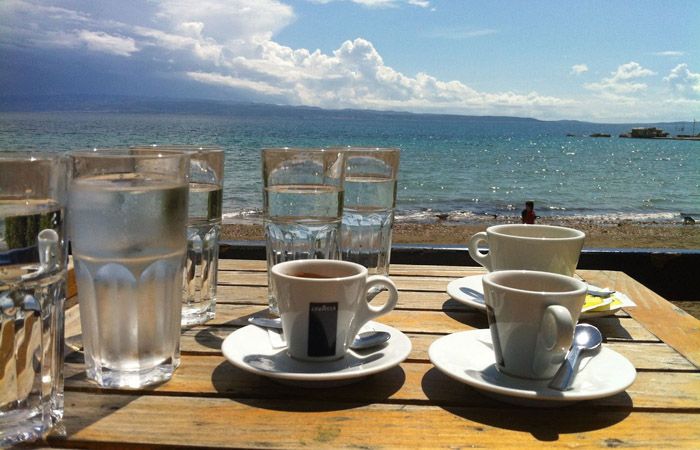
One of the features of Bačvice locals like the most is that it's a great place to hang around year-round, due to Split's great climate. Every weekend you can see thousands of people enjoying being outdoors, and sipping coffee anywhere from Bačvice beach eastbound is a mandatory ritual if you want to feel what is it like to be from Split. The most popular places are Žbirac overlooking the beach, Dvor, Ovčice, Kalafatić, and several others along the seaside promenade stretching for few kilometres. Also, there are some nice places away from the sea, like students' meeting point Aktuell

Bačvice, and surrounding area is one of the centers of Split nightlife. On the beach itself there are several clubs, and bars are open late, but probably the most popular venue is O'Hara music club, with daily DJ programs, and frequent live performances. During the summer concerts take place on a plateau in front of the club. There are also some other popular events, like the excellent Festival of Mediterranean Film

Downsides of staying in Bačvice are rare, its vicinity and good infrastructure is a sufficient reason to stay there. However, although most of this neighbourhood is really quiet, there are zones that sometime can be too noisy for families with children. So, if coming this way, avoid areas closer to the beach and clubs, youngsters coming home are loud creatures. Also, since it's a neighbourhood of mostly small houses, parking can be somewhat difficult, there are only two paid parking lots, everything else is left to your imagination for finding a place and driving skills.
To be continued
PREVIOUSLY IN WHERE TO STAY IN SPLIT
Choose Neighbourhood By Your Needs
Where To Stay In Split (5): Land Of Hajduk FC
For decades, the only activity associated with the neighbourhood called Poljud (pron. Pohlyood) in general Split mythology was football, or soccer, depending on which side of the Atlantic you're coming from. Local team Hajduk (Hidook), 103 years old and bigger than life in Split, has its home there since 1979, in a beautiful shell-like stadium. Since last year, however, there is another internationally recognized element of Poljud, both 'hood and stadium - Ultra Europe festival.
Poljud and nearby Spinut (Speanoot), settled on the northern side of Marjan hill, were only recently discovered as a possible place to stay while on vacation in Split, mostly because all attention was usually directed to the Old Town, and its neighbouring city parts. However, northern Split is very convenient for those not seeking a place to stay within the historical city core.

Most of the buildings - except in streets closer to Marjan - are rather new, built in the 1970s and 1980s, during Yugoslav times, meaning you will find typical socialism-era architecture, buildings raised for people working in local factories. It doesn't have to be as bad as it sounds, at least most of them are solid, fully equipped structures. In the last few years, since Split became a big thing in tourism, a lot of apartments were re-arranged into very decent accommodation. Another random AirBnB search for mid-June gave us a good deal of results.
Staying in Spinut/Poljud, as well as in some other newer neighbourhoods, is very convenient for those who arrive by car. It's much easier to find a parking space around buildings. Also, it's easily accessible from any direction, and going to an Old town for sightseeing is really a nice down-the-hill easy and short walk.

There are good sightseeing points in this neighbourhood too, some of them are among the major Split landmarks. We have already mentioned the stadium. Although it could be in better shape, the main attraction is the story of Hajduk, and any local will be more than happy to tell you about it.
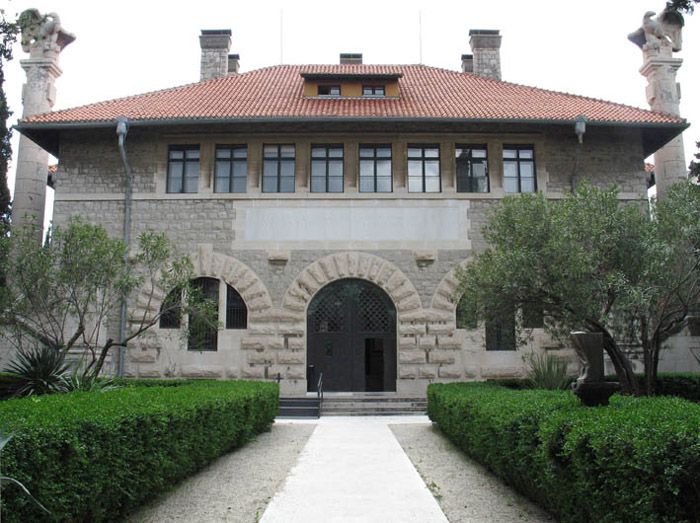
The biggest cultural and heritage spot is by far the Archeological Museum, with an incredible collection of Greek and Roman artefacts.

Another interesting spot for history-lovers might be the monastery of Saint Anthony, just by the stadium, with a true rarity - an 18th century painting depicting Muslim prophet Mohammad, one of very few in Europe.
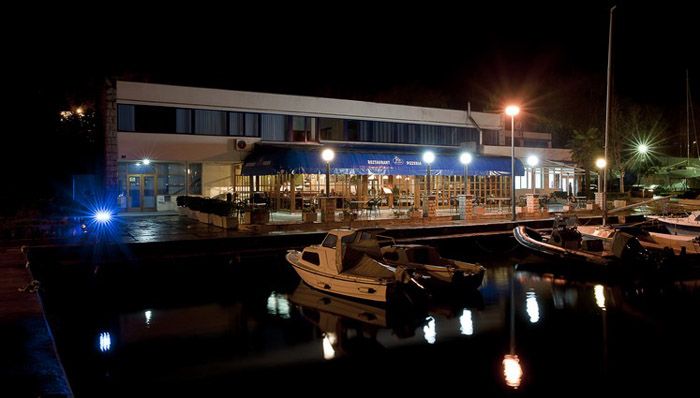
This neighbourhood is mostly residential, as we explained, and don't expect to find a lot of restaurants around. Some exceptions are around the sporting marina, where some middle class, but very reliable and inexpensive places are based, like Re di Mare, Lučica, Gusar, etc, with some of the most beautiful terraces in Split.

On the verge of this neighbourhood, there are also some of the main nightlife points in Split, like clubs Vanilla and Hemingway Bar. Maybe you won't like Croatian music there, but there are also some more versatile nights.
The downside of Poljud and Spinut might be that it's just too different from the parts of Split that maybe drew you here. It's a residential, family area, with not so much history around. Still, if you don't mind do a little walk, it can be attractive if you want to pay less for some comfortable accommodation. Except during the days of Ultra Europe, then you will always pay more.

To be continued
PREVIOUSLY IN WHERE TO STAY IN SPLIT
Choose Neighbourhood By Your Needs
Where To Stay In Split (4): A Neighbourhood With The View
Split has many nice views, but sitting anywhere on the south slopes on Marjan gives an oportunity for some real spectacles. Depending on the weather, just an easy hike brings a view that sometimes reaches most of the islands in front of Split, as far as Vis. This, the proximity of park-forest Marjan, just an easy walk to the city center, and the sheer luxury of villas based there, makes the southwest side of Split peninsula a really interesting choice as a vacation base.

These area is divided into few neighbourhoods, locally known as Meje (pron. Maeyae), Zvončac (Zvonchats), and simply Marjan (Maryan). It includes also the area around ACI marina with the newly renovated Western seaside promenade, and former cemetery, now park Sustipan.

As a place to stay, southern Marjan offers not so many possibilities as the old town or Varoš, but it's possible to find a range, from rooms to luxury villas in the residential area. a random search over AirBnB.com for early June gives about 60 facilities, but there are even more not listed. Unlike previously described neighbourhoods, this area is car-friendly, with a lot of places to park right in front of your accommodation, usually with a private parking space. It's easily accessible through Marjan tunnel, but our suggestion would be to leave your car there when going sightseeing, because it's not so easy to find a parking spot in the old town. Unfortunately, there are no hotels around. A few of them might be opened in the future, but right now Marjan Hilton is still under construction, as well as Ambasador, and the former residence of late Yugoslav president Josip Broz Tito was never returned into its original hotel assignation, being still a state-owned residence.

Restaurants are also rare, except for a few in and around the marina, one of the recent additions is very well received Zrno soli (Grain of Salt). It is also the same story with cafés, there are no many of them, but sipping coffee on a West Riva (locally Zapadna obala) is a nice experience, another great view on Split and surrounding mountains. Check out the plaques laid on West Riva, they mark all Split-native Olympic medal bearers.

Marjan itself doesn't give a lot of café oportunities, it's dedicated to different sorts of enjoyment, hiking, rock-climbing, biking, sightseeing, etc. The same kind of nature-bound enjoying provides park Sustipan, just above marina, once a cemetery and coronation site for old Croatian kings. One of the most attractive features are beaches around Marjan - the sea is everywhere very clean, and the most popular beaches like Kaštelet, Ježinac or Bene have nice cafés.

Don't expect much nightlife, this is another residential area, but whenever the weather is fine, West Riva will be packed with by-walkers, and those just enjoying sitting by the sea. Of course, as with Varoš - other, more party friendly areas are easily reachable.

Most tourists believe that there is not so much to see outside of the old town, but south Marjan has a few excellent museum experiences. The best known Split museum, Ivan Meštrović Gallery dedicated to the most famous Croatian sculptor is based there, as well as the adjacent Crikvine Kaštilac, also once owned by Meštrović.

A little bit closer to a city, lies Museum of Croatian Archeological Monuments, with early medieval treasures. Unfortunatelly, its permanent collection is in preparation, but the museum is worth visiting. This area is also a good staring point for a tour of Marjan churches.

Downsides of south Marjan is not so good public transportation connections with the city center. We have already said that it's not a very good idea to drive to the old town, so walking is probably the best option. It's an easy half-an-hour walk from Meštrović Gallery to Riva. Even though some parts of this area are pretty dark in the night, and Marjan forest is so close, it's pretty safe.
To be continued
PREVIOUSLY IN WHERE TO STAY IN SPLIT
Choose Neighbourhood By Your Needs
Where To Stay In Split (2): City Within The Imperial Palace
There is nothing more logical but to start this series with the very heart of Split, its historical center based in and around Diocletian's Palace. This is where Split was born. We all know the story about Roman emperor Diocletian, and his 1,700 years old palace where he spent his retirement days. For those who expect to see a palace as a building - in Split, the Palace is the city itself.

Nowadays, Split's historical core is on UNESCO's list of world historical heritage, earning that status in 1979, even before Venice. It consists of Diocletian's Palace, and medieval (or later) buildings inside the Palace and toward Riva (waterfront) or to the west up to Marmontova street and colonades on Prokurative. Also, the old town includes Riva, the colourful green market, and the area north of Palace, with city Giardino, Art museum complex, and statue of Gregory of Nin, among other things.
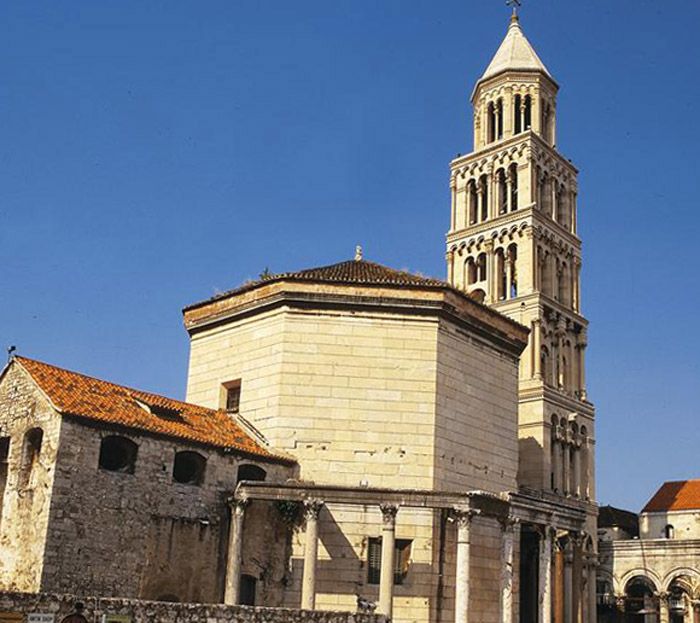

Almost all historical attractions in Split are based in the city's centre, it's a collection of at least Top 10 "what to see" in Split, including Peristil, Palace's substructures, Diocletian's quarter, all main city squares, churches, etc. Also, most of the popular restaurants and cafés are there, like Zinfandel, Uje, No Stress, Dva Tona, Bajamonti, Teak, Tinel, Fro, and many, many others, especially in the main season.

Of course, all this has made the city center the most popular for accommodation, with several boutique hotels like Vestibul, Judita, Peristil, Marmont, and countless apartments and private rooms. Staying in such a historical and important environment usually means higher prices, and it is the case in most venues in Split's center. Still, views of the old city, and close proximity to all the attractions usually means that staying in historical core means value for money.

Although it's great to stay in Split's heart, there are also downsides. First, it's not very friendly to those arriving to Split by car, since parking is a chronic problem in this city. Further, in the high season it's possible you won't get a nice, quiet sleep due to a noise from streets, squares, restaurants, bars. Split centre is not the place for a quiet, family vacation, except in some parts, such as near Vestibul. Still, like almost anywhere in the city, it's safe to stroll around even late in the night.

There is another thing any guest should take in account. Split is a historical city, but its full value and beauty is in its life. Even though Diocletian's Palace is a globally important monument, it's also a place where people live. Respect that fact, don't argue too harshly if someone complains about the noise, he or she is probably going to work next morning. If you were in Dubrovnik, you probably didn't see many locals, but Split is very different. Take advantage of of that fact, check out where locals go, and join them, it's usually a good recipe for an even better vacation, including visiting the fishmarket, green market, and sipping coffee on Riva or any given square.

(to be continued)
PREVIOUSLY IN WHERE TO STAY IN SPLIT
Where To Stay In Split (1): Choose Neighbourhood By Your Needs
There are hundreds, even thousands of options where to stay in Split, a variety of hotels, hostels and especially rooms and apartments, and the choice is seemingly endless. However, when it comes to the final decision, when you narrow your selection on Booking.com or Airbnb.com or any other site, one of the main questions is "which neighbourhood to choose". Especially for first time visitors, most of them are complete terra incognita, not to mention sometimes truly unpronouncable names.
Like in any other city, every neighbourhood in Split has its pros and cons, its ups and downs, and reasons why or why not to hang around. In this new Total Split series we will try to give you hints what does it mean when some apartment owner gives you information that they are in Varos, Get, Marjan, Poljud, Bacvice, Radunica... All these parts of Split have their history, their unique atmosphere, different accessibility, or, in short, important reasons for and against. Each one of them will offer you different oportunities for nightlife, a quiet vacation, enjoying history or good food, or to be closer to nature.
For starters, it's good to know that since last year almost whole Split is included in Street View on Google Maps. This way anyone can browse around pretty much any properties offered on booking sites.
To be continued

